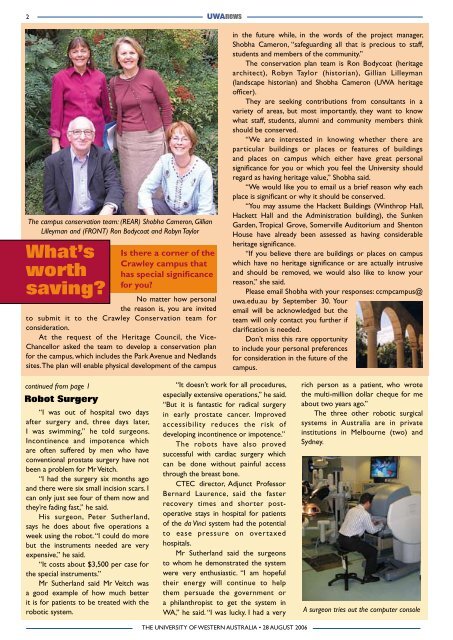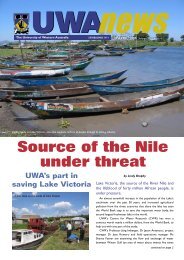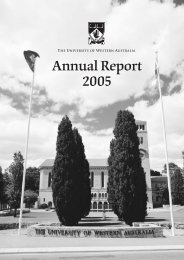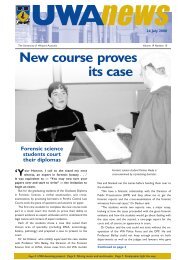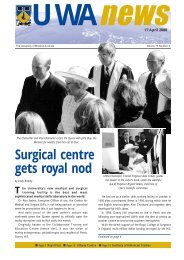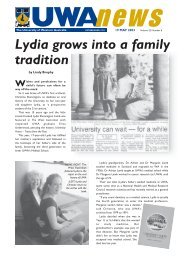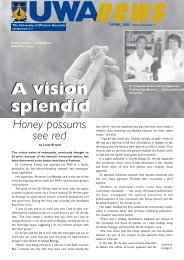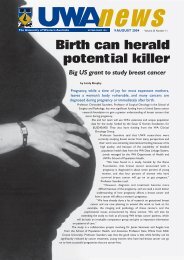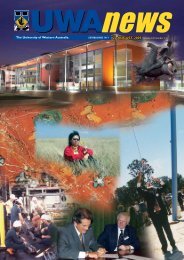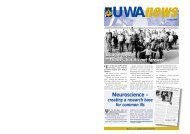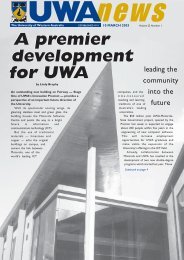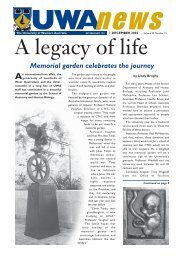28 Aug : Vol 25, #12 - UWA News staff magazine - The University of ...
28 Aug : Vol 25, #12 - UWA News staff magazine - The University of ...
28 Aug : Vol 25, #12 - UWA News staff magazine - The University of ...
- No tags were found...
You also want an ePaper? Increase the reach of your titles
YUMPU automatically turns print PDFs into web optimized ePapers that Google loves.
<strong>UWA</strong>news<strong>The</strong> campus conservation team: (REAR) Shobha Cameron, GillianLilleyman and (FRONT) Ron Bodycoat and Robyn TaylorWhat’sworthsaving?Is there a corner <strong>of</strong> theCrawley campus thathas special significancefor you?No matter how personalthe reason is, you are invitedto submit it to the Crawley Conservation team forconsideration.At the request <strong>of</strong> the Heritage Council, the Vice-Chancellor asked the team to develop a conservation planfor the campus, which includes the Park Avenue and Nedlandssites. <strong>The</strong> plan will enable physical development <strong>of</strong> the campusin the future while, in the words <strong>of</strong> the project manager,Shobha Cameron, “safeguarding all that is precious to <strong>staff</strong>,students and members <strong>of</strong> the community.”<strong>The</strong> conservation plan team is Ron Bodycoat (heritagearchitect), Robyn Taylor (historian), Gillian Lilleyman(landscape historian) and Shobha Cameron (<strong>UWA</strong> heritage<strong>of</strong>ficer).<strong>The</strong>y are seeking contributions from consultants in avariety <strong>of</strong> areas, but most importantly, they want to knowwhat <strong>staff</strong>, students, alumni and community members thinkshould be conserved.“We are interested in knowing whether there areparticular buildings or places or features <strong>of</strong> buildingsand places on campus which either have great personalsignificance for you or which you feel the <strong>University</strong> shouldregard as having heritage value,” Shobha said.“We would like you to email us a brief reason why eachplace is significant or why it should be conserved.“You may assume the Hackett Buildings (Winthrop Hall,Hackett Hall and the Administration building), the SunkenGarden, Tropical Grove, Somerville Auditorium and ShentonHouse have already been assessed as having considerableheritage significance.“If you believe there are buildings or places on campuswhich have no heritage significance or are actually intrusiveand should be removed, we would also like to know yourreason,” she said.Please email Shobha with your responses: ccmpcampus@uwa.edu.au by September 30. Youremail will be acknowledged but theteam will only contact you further ifclarification is needed.Don’t miss this rare opportunityto include your personal preferencesfor consideration in the future <strong>of</strong> thecampus.continued from page 1Robot Surgery“I was out <strong>of</strong> hospital two daysafter surgery and, three days later,I was swimming,” he told surgeons.Incontinence and impotence whichare <strong>of</strong>ten suffered by men who haveconventional prostate surgery have notbeen a problem for Mr Veitch.“I had the surgery six months agoand there were six small incision scars. Ican only just see four <strong>of</strong> them now andthey’re fading fast,” he said.His surgeon, Peter Sutherland,says he does about five operations aweek using the robot. “I could do morebut the instruments needed are veryexpensive,” he said.“It costs about $3,500 per case forthe special instruments.”Mr Sutherland said Mr Veitch wasa good example <strong>of</strong> how much betterit is for patients to be treated with therobotic system.“It doesn’t work for all procedures,especially extensive operations,” he said.“But it is fantastic for radical surgeryin early prostate cancer. Improvedaccessibility reduces the risk <strong>of</strong>developing incontinence or impotence.”<strong>The</strong> robots have also provedsuccessful with cardiac surgery whichcan be done without painful accessthrough the breast bone.CTEC director, Adjunct Pr<strong>of</strong>essorBernard Laurence, said the fasterrecovery times and shorter postoperativestays in hospital for patients<strong>of</strong> the da Vinci system had the potentialto ease pressure on overtaxedhospitals.Mr Sutherland said the surgeonsto whom he demonstrated the systemwere very enthusiastic. “I am hopefultheir energy will continue to helpthem persuade the government ora philanthropist to get the system inWA,” he said. “I was lucky. I had a veryrich person as a patient, who wrotethe multi-million dollar cheque for meabout two years ago.”<strong>The</strong> three other robotic surgicalsystems in Australia are in privateinstitutions in Melbourne (two) andSydney.A surgeon tries out the computer consoleTHE UNIVERSITY OF WESTERN AUSTRALIA • <strong>28</strong> august 2006


